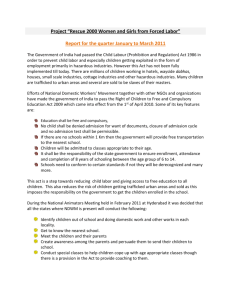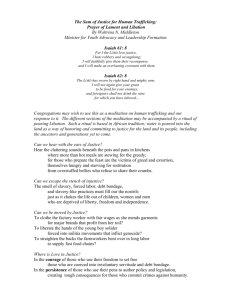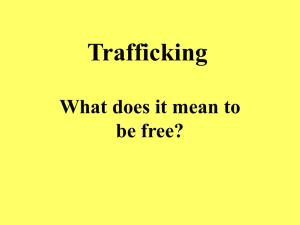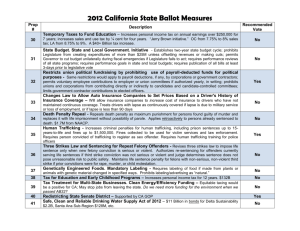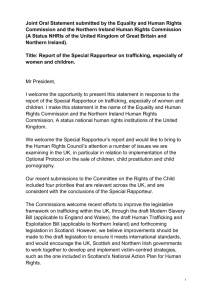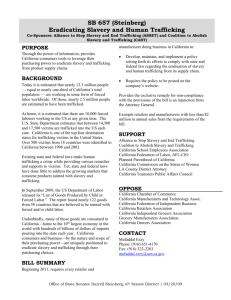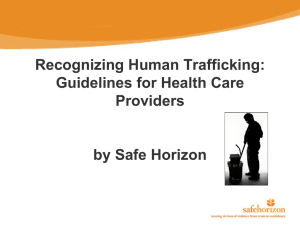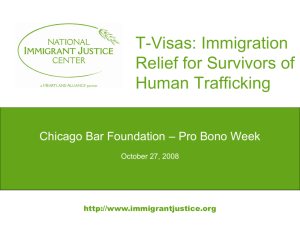PowerPoint Presentation - Human Trafficking: Clinical Presentation
advertisement
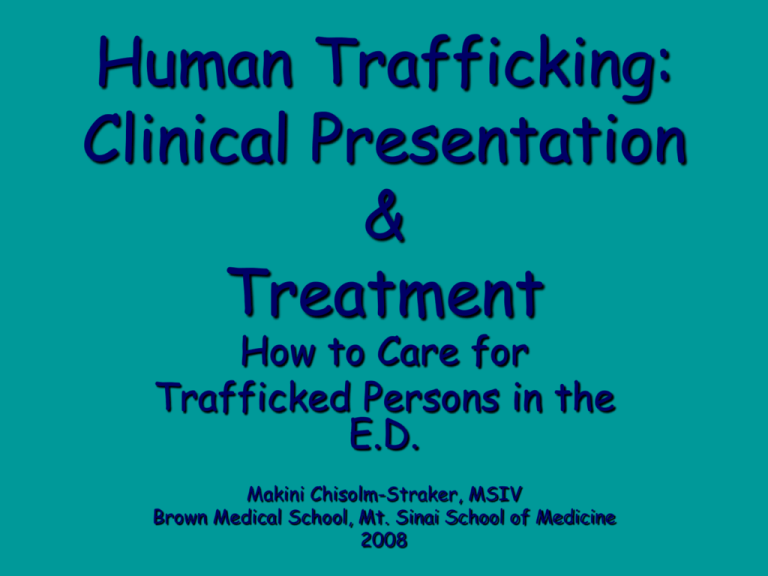
Human Trafficking: Clinical Presentation & Treatment How to Care for Trafficked Persons in the E.D. Makini Chisolm-Straker, MSIV Brown Medical School, Mt. Sinai School of Medicine 2008 Instructional Goals: • You will be familiar with the clinical presentation of human trafficking victims in the E.D. in the U.S. • You will be familiar with the appropriate treatment of human trafficking victims. • You will appreciate the role of emergency healthcare practitioners in facilitating the escape of trafficked persons. Instructional Learning Objective (what you will do by the end of this session): You will know the hotline to call when a suspected trafficking victim presents to the emergency department. Case • obtunded teenage ♀, GCS 5 • extensive bleeding from vaginal canal • visible burns, cuts, scars on wrists, ankles, neck • h/o schizophrenia? • bro. concerned about a dangerous abortion attempt Human Trafficking is: • the recruitment, transportation, transfer, harboring or receipt of persons: – by the threat or use of kidnapping, force, fraud, deception or coercion, or by the giving or receiving of unlawful payments or benefits – to achieve the consent of a person having control over another person, and – for the purpose of sexual exploitation or forced labor. Human Trafficking is: • the illegal use of a variety of means • to force an individual (the trafficked) • to relinquish his/her personal freedom • for the profit of another person (the trafficker). • often, simply considered “involuntary servitude” or “modern-day slavery.” Types of Trafficking Sexual Exploitation • prostitution • pornography • bride trafficking • commercial abuse of children • massage parlors, hostess clubs, brothels, escort services, commercial phone sex & internet dating • exotic dancing/stripping Types of Trafficking Forced Labor • domestic servitude (domestic work & child care) • manual labor -small-scale factory work -construction work -sweatshops & farms of multinational corps -agricultural & landscape work • restaurants • nail salons • hotel housekeeping • • • • • • false adoption drug trade street begging camel jockeys child soldiers organ harvesting Trafficking Affects (Populations at Risk): •15,000 – 60,000 people are trafficked into the U.S. annually •80% of trafficked persons are ♀ & children •U.S. citizens •U.S. residents •documented immigrants •undocumented immigrants •youth (esp. runaways) •urban pop. •suburban pop. Role of Healthcare Practitioners in the E.D. • Identify human trafficking victims • Treat the chief complaint/illness and/or the emergent issue • Offer (& provide, if patient-desired) appropriate treatment for the unsafe environment Difficulty Identifying Trafficking Victims • distrust of service providers • lies & false stories • untrustworthy interpreters • “one shot” • difference between intimate partner violence & human trafficking Signs & Sx • • • • • • • • lack of knowledge of a given community/whereabouts not in control of personal ID few no personal possessions does not speak 3rd party insists on being present or interpreting injuries (multiple, old & new) signs of malnourishment branding Signs & Sx • • • • • • • • no healthcare under 18 & in sex industry – DE FACTO claim of “just visiting” inconsistent story behavior change when “law enforcement” is mentioned STIs bacterial &/or yeast infxns demeanor (e.g.: fearful, anxious, submissive, flat affect) What to do What to do 1. 2. 3. 4. 5. 6. 7. building trust is the number one priority reassure the potential victim one-on-one interactions are ideal specifically ask about the patient’s safety offer reworded stories stay calm & even-keel ALWAYS document your suspicion in your notes, at the very least 8. Call a Help Hotline: English: 1-888-373-7888 Korean: 1-888-976-5274 Spanish: 1-888-80-AYUDA The folks working at the hotlines are trained to know how to help you, but you are their eyes & ears. Trust their knowledge, your experience & your gut. If the patient is an adult, they have the last say, but give them every opportunity to receive help. Even if a potential victim doesn’t want help, call: 1 - 8 8 8 - 3 7 3 - 7 8 8 8, to report suspected trafficking; the tip can save lives. Clinical Recommendations* Presumptive Treatment for: • gonorrhea • chlamydia • trichomoniasis • syphilis • UTI *for sexually exploited victims Special thanks to Polaris Project for the images & information. Clinical Recommendations courtesy of Doctors of the World. For more information on trafficking in the U.S. you can: email: m.chisolmstraker@gmail.com visit: www.polarisproject.org or www.humantraffickingED.com


